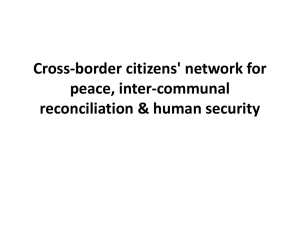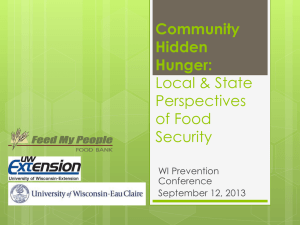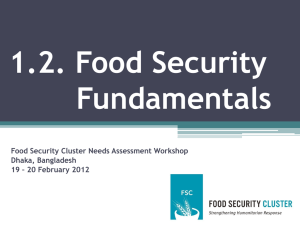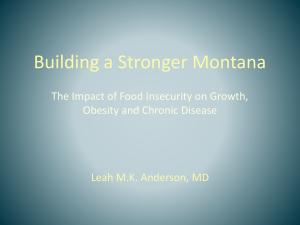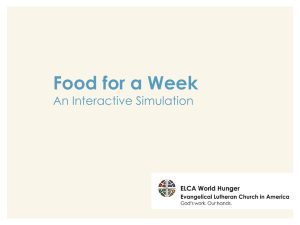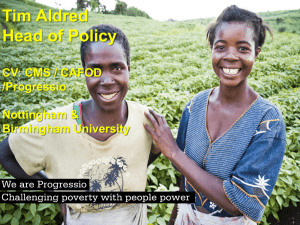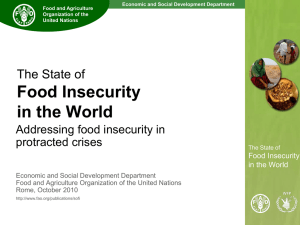Lecture 1: Context of food insecurity
advertisement
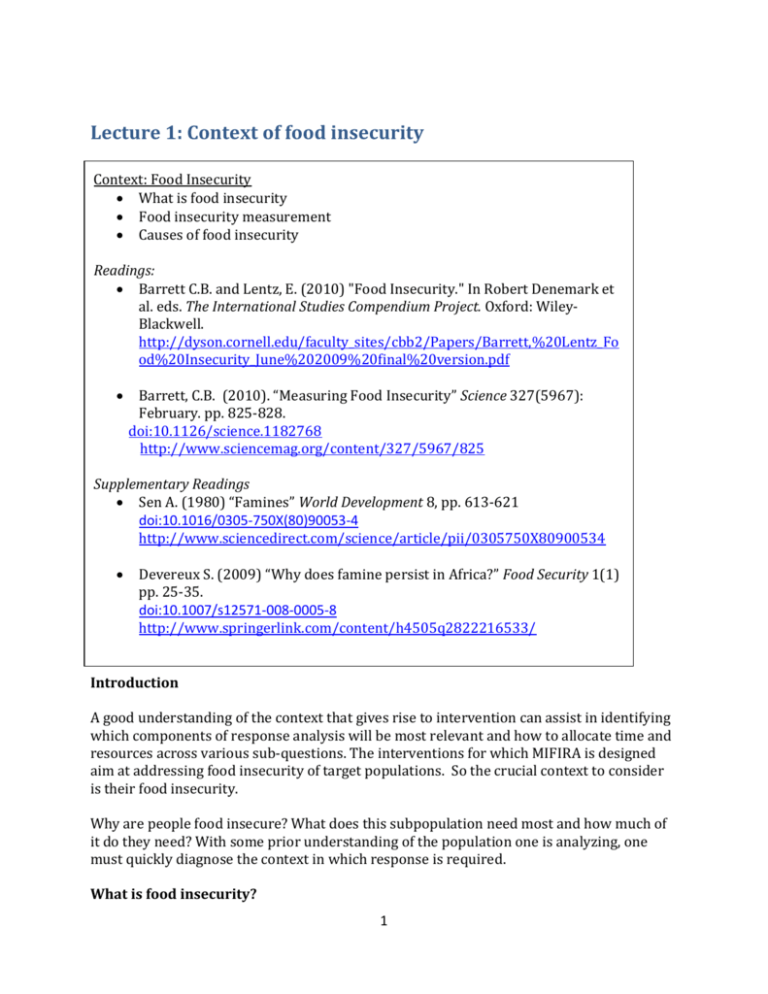
Lecture 1: Context of food insecurity Context: Food Insecurity What is food insecurity Food insecurity measurement Causes of food insecurity Readings: Barrett C.B. and Lentz, E. (2010) "Food Insecurity." In Robert Denemark et al. eds. The International Studies Compendium Project. Oxford: WileyBlackwell. http://dyson.cornell.edu/faculty_sites/cbb2/Papers/Barrett,%20Lentz_Fo od%20Insecurity_June%202009%20final%20version.pdf Barrett, C.B. (2010). “Measuring Food Insecurity” Science 327(5967): February. pp. 825-828. doi:10.1126/science.1182768 http://www.sciencemag.org/content/327/5967/825 Supplementary Readings Sen A. (1980) “Famines” World Development 8, pp. 613-621 doi:10.1016/0305-750X(80)90053-4 http://www.sciencedirect.com/science/article/pii/0305750X80900534 Devereux S. (2009) “Why does famine persist in Africa?” Food Security 1(1) pp. 25-35. doi:10.1007/s12571-008-0005-8 http://www.springerlink.com/content/h4505q2822216533/ Introduction A good understanding of the context that gives rise to intervention can assist in identifying which components of response analysis will be most relevant and how to allocate time and resources across various sub-questions. The interventions for which MIFIRA is designed aim at addressing food insecurity of target populations. So the crucial context to consider is their food insecurity. Why are people food insecure? What does this subpopulation need most and how much of it do they need? With some prior understanding of the population one is analyzing, one must quickly diagnose the context in which response is required. What is food insecurity? 1 The standard definition, agreed at the 1996 World Food Summit, holds that food security represents “a situation that exists when all people, at all times, have physical, social and economic access to sufficient, safe and nutritious food that meets their dietary needs and food preferences for an active and healthy life.” Food security is commonly conceptualized as resting on three pillars: 1) availability 2) access 3) utilization These concepts are inherently hierarchical, with availability necessary but not sufficient to ensure access, which is, in turn, necessary but not sufficient for effective utilization. Sometimes analysts add a fourth pillar: 4) stability. Per Capita Nutrient Availability (shaded areas below minima) Protein/day (grams) 140 120 10.3% 70.3% 16.6% 2.9% 100 80 60 40 20 1000 2000 3000 Calories/day 4000 Source: Barrett & Maxwell (2005), data: FAO food balance sheets Availability reflects the supply side of the food security concept. In order for all people to have “sufficient” food, there must be adequate availability. That is commonly not the case. Roughly two-thirds of African countries have inadequate calorie and protein supplies to meet international standards even if food were perfectly equitably distributed (which it obviously isn’t). The graphic above, which plots national level macronutrient availability data from the FAO food balance sheets, underscores that food availability remains a major issue in many countries (including in 30/47 countries in Sub-Saharan Africa). Access is most closely related to the social science concepts of individual or household well-being: what is the range of food choices open to the person(s), given their income, prevailing prices, and formal or informal safety net arrangements through which they can access food? As Nobel Laureate Amartya Sen wrote in the opening sentences to his famous 1981 book Poverty and Famines, “starvation is the characteristic of some people not having enough food to eat. It is not the characteristic of there being not enough food to eat. While the latter can be a cause of the former, it is but one of many possible causes.” Access reflects the demand side of food security, as manifest in uneven inter- and intra-household food distribution and in the socio-cultural limits on what foods are consistent with 2 prevailing tastes and values within a community. Access also accentuates problems responding to adverse shocks such as unemployment spells, price spikes or the loss of livelihood-producing assets. Through the access lens, food security’s close relationship to poverty and to social, economic, and political disenfranchisement comes into clearer focus. Distribution of poor net buyers/sellers of food staples 100% 90% 80% Percentage 70% 60% 50% 40% 30% 20% 10% 0% Bolivia Ethiopia Bangladesh Cambodia Urban (net buyers) Smallholders (net buyers) Smallholders (net sellers) Zambia Madagascar Vietnam Rural landless (net buyers) Smallholders (self-sufficient) Source: World Bank (2008) One common error many analysts make comes from thinking that higher food prices inevitably benefit those who rely on farming as their primary source of income. In lowincome countries, most of the poor rely heavily on agriculture for their livelihood, yet most farm household consume more food than they produce, filling the gap with transfers (food aid, gifts from family and friends) or purchases using off-farm and non-farm earnings. The figure below shows that net sellers routinely represent no more than one-third of the population, commonly less than 10% of the population. Therefore, although higher food prices can induce increased food production (with a lag) and thereby help address food availability concerns, they tend to exacerbate food access problems. With limited capacity to increase nominal incomes quickly, rapid food price increases can seriously threaten the food security of the poor, including small farmers. Utilization reflects concerns about whether individuals and households make good use of the food to which they have access. Do they consume nutritionally essential foods they can afford or do they choose a nutritionally inferior diet? Are the foods safe and properly prepared, under sanitary conditions, so as to deliver their full nutritional value? Is the health of the consumers such that they absorb and metabolize essential nutrients? Utilization concerns foster greater attention to dietary quality, especially micronutrient deficiencies associated with inadequate intake of essential minerals and vitamins. 3 Stability is considered a fourth pillar by some analysts and agencies (e.g., FAO). Stability captures the susceptibility of individuals to food insecurity due to interruptions in access, availability or utilization. Certain individuals within communities or households may be more vulnerable to instability and are at greater risk of food insecurity. This matters for targeting of interventions and the design of safety nets intended to safeguard food security for vulnerable subpopulations. Food price instability, in particular, has tended to grow over the past generation in spite of globalizing markets (which, in theory, should dampen price volatility) and reawakened interest in buffer stocks, price controls and other instruments to reduce instability in access due to price volatility. Real Prices of Food Commodities, 1960-2007 500 450 400 350 Wheat 300 Rice Petroleum 250 Maize 200 150 100 50 0 1960 1965 1970 1975 1980 1985 1990 1995 2000 2005 Source: International Monetary Fund, International Financial Statistics Online The temporal aspect of stability links to the distinction between chronic and transitory food insecurity. Chronic food insecurity reflects a long-term lack of access to adequate food, and is typically associated with structural problems of availability, access or utilization. Although the most severe food insecurity is typically associated with disasters such as drought, floods, war or earthquakes, most food insecurity is not associated with catastrophes, but rather with chronic poverty. Transitory or acute food insecurity, by contrast, is associated with sudden and temporary disruptions in availability, access or, less commonly, utilization. 4 The most common transitory food insecurity is seasonal, recurring quite predictably, especially among rural populations during the period preceding harvest, when grain stocks run low and food prices typically hit annual peaks. The attached graphic shows, for example, seasonal maize prices in western Kenya over the course of July 2004-July 2005. Prices hit annual lows as the main harvest comes in, then rise (not always smoothly), with a large gap typically emerging between sales and purchase prices in the immediate postharvest period as poor farmers seeking cash sell commodity even though they anticipate buying the same commodity back several months later. Source: Stephens and Barrett 2011. Some transitory food insecurity is regular but aperiodic, as in the case of droughts that routinely strike semi-arid regions or floods that sporadically hit low-lying coastal areas. And some food insecurity is associated with conflict. The most serious episodes of transitory food insecurity are commonly labeled “famine”, meaning mass mortality associated with a food crisis. At least since Malthus, famines were long thought to arise primarily due to supply shocks that reduced food availability. But beginning with Sen, this view was largely eclipsed by one focused more on access. Today, it is widely recognized that famine is typically associated with multiple factors – a critical food shortage, mass unemployment, food price spikes, etc. – and is attributable chiefly to response failures due to insufficient political will rather than to inadequate early warning or response capacity. Response analysis is important to shape effective response. But ultimately the key is usually the political will to mobilize financial and human resources to respond to a crisis. Food insecurity measurement 5 Food insecurity measurement matters for at least three major reasons. First, each measure captures and neglects different phenomena intrinsic to the concept of food security, thereby subtly influencing prioritization among food security interventions. Historically, reliance on national food availability estimates focused attention on food aid shipments and agricultural production strategies to increase food supplies in the short and long term, respectively. Over roughly the past quarter century, Sen’s core thesis – that food access accounts for most food insecurity – has focused increased attention on individual-specific hunger and underweight data, which naturally reinforces strategies based on poverty reduction, food price, social protection policies. For example, the voluntary guidelines on the right to adequate food, unanimously agreed by all FAO member states in 2004, was a response to lack of progress in individual-level indicators in spite of growth in aggregate food supplies and incomes. Second, observational data necessarily report on the past. But policymakers are most interested in the likely future effects of prospective interventions. An ideal food security indicator would reflect the forward-looking time series of probabilities of satisfying the access criteria. Yet there has been little effort to date in testing the forecasting accuracy of currently available indicators. Third, national-level measures inherently lend themselves only to addressing nationalscale food availability shortfalls, not intra-national access and utilization concerns. Insofar as food insecurity measures diagnostically inform actions, they must be readily associated with targetable characteristics of vulnerable households and individuals and remediable causal factors that lead to food insecurity. The research frontier therefore revolves around the development of cross-nationally comparable, longitudinal monitoring and analysis at household and individual level. Causes of food insecurity Effective, direct food security interventions depend on effective targeting of the vulnerable subpopulation(s) and of the causes of insecurity, as well as prompt response. Where data collection is timely, causal factors can be robustly associated with food insecurity measures, and when predictive models have demonstrable accuracy, preventive measures can substantially reduce unnecessary human suffering. The long-term consequences of crises can be limited where appropriate policies and institutions are already in place, such as social protection schemes to cushion people in times of adversity and early childhood health programs to protect the most vulnerable from even short-lived interruptions in essential nutrient intake. So what are key causes of food insecurity? Food insecurity has multiple causes which coexist at the individual, household, community, and national levels. A solid understanding of the (“covariate”) causes of food insecurity that are common to a broad subpopulation (due, for example, to crop yields, food prices, wages, civil unrest) is essential to generalized interventions (e.g., food aid, famine early warning systems) and to long-term, aggregate improvement in food security at the level of communities, countries and regions. Meanwhile, an understanding of the individual-level (“idiosyncratic”) causes of food 6 insecurity is essential to successful targeting of interventions to particular food insecure persons. Since most food insecurity is chronic, we start with the core causes of chronic food insecurity. Many places suffer widespread chronic food insecurity because the high costs of food marketing make food locally nontradable and local agricultural production is relatively unproductive. Because domestic food production dwarfs cross-border commercial food trade or international food aid shipments (see figure below), low domestic agricultural productivity – which limits food availability and rural incomes – remains a primary cause of covariate chronic food insecurity in low-income countries. Global Annual Cereal Flows 60 400 Production (read against right axis) 350 300 40 250 Commerical imports (read against left axis) 30 200 150 20 100 Ceral Production in kilograms per person Cereal Trade and Aid in kilograms per person 50 10 50 Food aid (read against left axis) 0 1970 0 1975 Source: FAO, FAOStat database 1980 1985 1990 1995 2000 2005 Years Following Sen, however, we know that low incomes more broadly – regardless of whether they originate in low agricultural productivity – are the single best explanatory variable behind food insecurity. This comes through very clearly in aggregate data, such as the plot below that associates prevalence rates of both child stunting – a long-term measure of malnutrition based on height-for-age anthropometric measures – and child wasting – a measure of short-term malnutrition based on weight-for-height measures – with national incomes. Given dispersion of incomes within countries, however, the experience of poverty is not uniform. Thus income poverty is typically the main cause of idiosyncratic chronic food insecurity. Response to this sort of deprivation requires targeting to reach the poor effectively and to not waste resources on those who do not need it. The main cause of transitory covariate food insecurity is typically a sharp increase in food prices. A large majority of the world’s population depends on markets for access to food. Adverse movements in the terms of trade between purchased food and the goods or services they produce and sell (including wage labor) can cause “entitlements” failures (entitlements is the term Sen uses to describe the set of bundles of commodities that a person can command based on the opportunities and rights available to her). Price spikes 7 can be catastrophic for poor populations, who commonly spend half or more of their total income on food. Episodically, food prices can increase sharply, especially where markets are poorly integrated or noncompetitive. Then a local supply shock – including a shock caused by speculative storage that removes commodity from the market temporarily – can precipitate price spikes that can trigger acute, widespread food insecurity. Those most at risk lack reliable access to markets, impairing their ability to smooth consumption. Transitory covariate food insecurity can also be split into periodic insecurity, which are predictable events such as seasonal hunger and aperiodic but regular insecurity, which occurs with some frequency but not predictably, such as households facing droughtinduced insecurity. 60 25 50 20 40 15 30 10 20 5 10 0 0 0 5,000 10,000 % children <5 years stunted (ca. 2006) Child Stunting and Wasting, by National Income 30 15,000 Note: the left-hand side axis denotes the percent of children under five wasted (circa 2006) while the right hand side axis denotes the percent of children under five stunted (circa 2006). The x-axis is GDP, circa 2006. Source: Barrett and Lentz (2010) “Food Insecurity” in Denemark ed. The International Studies Compendium Project. Oxford: Wiley-Blackwell. The main driver of transitory idiosyncratic food insecurity is livelihood disruption. When someone loses a job, falls ill and temporarily cannot work, suffers a localized crop failure (e.g., due to wildlife damage, localized pest infestation) or loses key productive 8 livestock to disease or predators, the food security effects can be severe. If the (formal and informal) safety net is solid, acute food insecurity can commonly be avoided or at least short-lived. One last cause of food insecurity merits mention in the context of MIFIRA. Market access is impeded primarily by excessive transactions costs, including the absence of good market information, hence the disproportionate concentration of the food insecure in areas with rudimentary communications, storage, and transport infrastructure. Macroeconomic problems such as binding foreign exchange constraints or trade barriers often exacerbate more localized problems. But market access is commonly idiosyncratic. It varies by socioeconomic status, by gender, age and religion (where there may be sociocultural obstacles to participation in certain economic activities), and by geography and physical health (where there may be difficulties reaching trading points or aid distribution centers). Market access is a central factor behind idiosyncratic food insecurity, both transitory and chronic. 9
